
Epyaxa lucidata is a species of moth in the family Geometridae. It is endemic to New Zealand.

Xyridacma ustaria is a moth of the family Geometridae. It was first described by Francis Walker in 1863 from specimens obtained in Auckland. It is endemic to New Zealand. X. ustaria has been found on Codfish Island in May with larvae recorded on Pittosporum tenuifolium. It has also been found at Paroa in February as well as in Canterbury.
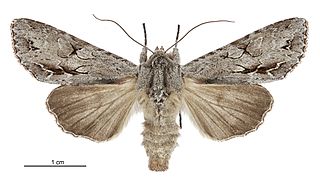
Ichneutica ustistriga is a moth of the family Noctuidae. It is endemic to New Zealand and can be found from the Three Kings Islands to Stewart Island. This species lives in a wide variety of habitats including domestic gardens, horticultural areas, orchards, native and exotic grasslands, as well as native forest. The larvae eat a variety of herbaceous plants. Recorded food plants include Muehlenbeckia australis, Muehlenbeckia complexa, Olearia hectorii, and Plantago lanceolata. This moth has a mauvish grey wing colour and is unlikely to be confused with other species as the patterns on its forewing are distinctive. This species is on the wing throughout the year and is attracted to both sugar and light traps. Adult moths can be found at rest on fences and tree trunks during the day.

Xyridacma is a genus of moths in the family Geometridae erected by Edward Meyrick in 1888.
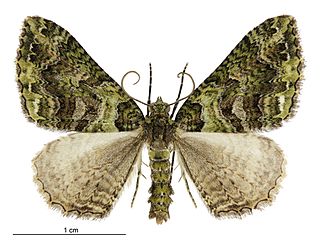
Austrocidaria similata is a species of moth of the family Geometridae. It endemic to New Zealand.
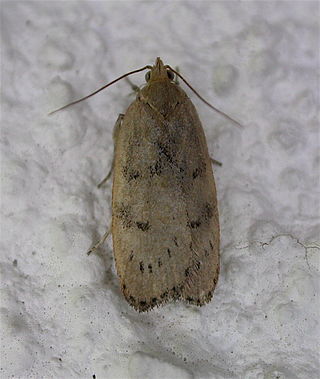
Phaeosaces coarctatella is a species of moth in the family Oecophoridae. It is endemic to New Zealand and can be found throughout the country. The preferred habitat of this species is native forest however they can also be found in domestic gardens. Larvae shelter in hollow twigs or under bark and emerge at night to browse on lichens. They pupate within their shelter. Adults are on the wing from September to January and are variable in their appearance. They vary both in colour, from reddish brown to a greenish yellow shade, and also in the extent of the black marking on their forewings. They are nocturnal and are attracted to light.
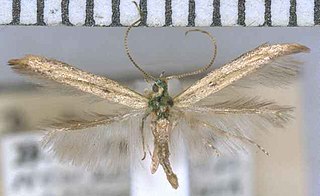
Batrachedra arenosella, the armoured scale eating caterpillar or the coconut moth, is a species of moth of the family Batrachedridae. It was first described by Francis Walker using specimens collected in Auckland, New Zealand. It has been hypothesised that the New Zealand moth may contain two distinct species. As well as the moth species in New Zealand, this name has been applied, perhaps incorrectly, to moths found in India, Indonesia, the Malay Peninsula, and Réunion, as well as in Australia, from the Northern Territory and northern Queensland to New South Wales and South Australia.
Stigmella maoriella is a species of moth in the family Nepticulidae. It is endemic to New Zealand. It is classified as Not Threatened by the Department of Conservation.

Eudonia minualis is a species of moth of the family Crambidae. It was described by Francis Walker in 1866. It is endemic to New Zealand.

Dumbletonius characterifer is a species of moth of the family Hepialidae. It is endemic to New Zealand. It was first described by Francis Walker in 1865.

Declana atronivea, commonly called the North Island lichen moth or North Island zebra moth, is a moth of the family Geometridae. It is endemic to New Zealand and found only in the North Island.

Orthoclydon praefectata, the flax looper moth or flax window maker, is a moth of the family Geometridae. It is endemic to New Zealand.
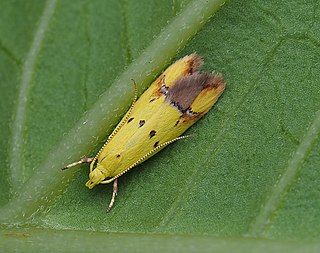
Gymnobathra flavidella is a species of moth in the family Oecophoridae. It is endemic to New Zealand. The host plants for the larvae of this species include Brachyglottis repanda and Gahnia procera.
Eudonia linealis is a species of moth in the family Crambidae. This species is endemic to New Zealand. It is classified as "Data Deficient" by the Department of Conservation.

Eudonia sabulosella is a species of moth in the family Crambidae. This species is endemic to New Zealand and is regarded as being common. The larvae of this species are known to damage pasture in New Zealand.

Proteuxoa comma is a species of moth in the family Noctuidae. It is endemic to New Zealand. It can be found in the lower half of the North Island and throughout the South Island, although it appears to be more frequent on the eastern side of these islands, and also is present in Stewart Island. P. comma is very similar in appearance to P. tetronycha but can be distinguished as it is a larger moth with slightly different colouration on, as well as shape of, its forewings. This species pupates in the soil. The adult moths are on the wing from December to April. P. comma may possibly be declining in population and as at 2017 a reassessment of its conservation status is regarded as being needed.

Xyridacma veronicae, also known as the striped veronica moth, is a moth of the family Geometridae. It was described in 1934 by Louis Beethoven Prout. It is endemic to New Zealand.

Cleora scriptaria, the kawakawa looper moth, is a moth in the family Geometridae endemic to New Zealand.
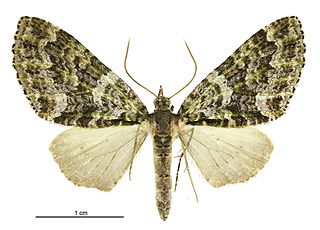
Tatosoma agrionata, also known as the mistletoe carpet moth, is a species of moth in the family Geometridae first described by Francis Walker in 1862. It is endemic to New Zealand. It is classified as at risk, declining by the Department of Conservation.


















